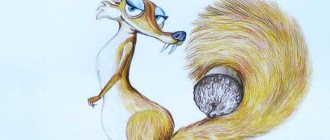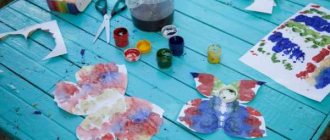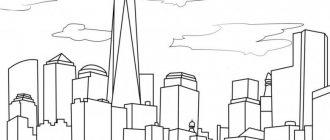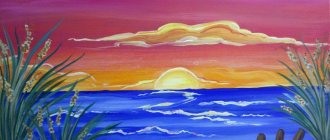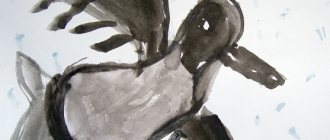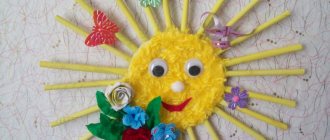Progress of the lesson.
Children sit in a semicircle on chairs. An audio recording of a song from the cartoon “The Adventures of Captain Vrungel”
.
The teacher brings Captain Vrungel (a toy) into the group room, speaks for him.
Captain Vrungel. I wish you good health, children! I, Captain Vrungel, have heard a lot about how kind and skillful you are. I had a misfortune and I want you to help me .
Educator. What happened to you, captain?
Captain Vrungel. During a storm, my favorite yacht “Trouble”
sank.
Now I am a captain without a ship and cannot continue my voyage.
Educator. Don't be sad, captain, we will definitely help you. Just explain what kind of ship ?
Captain Vrungel. Strong, reliable and beautiful, in general, like my “Trouble”
.
Unfortunately, only this photograph remains from her (shows the picture)
.
Educator. Well, guys, let's help Captain Vrungel? Shall we draw him a sailing ship so that he can continue to sail the seas and oceans?
Children. Yes, we'll draw it.
Educator. Then let's go to the tables and draw Captain Vrungel his ship . And you, dear captain, sit with us and watch how the kids try .
Educator. Before you start drawing a sailing ship , I will teach you guys how to do it (comes to the easel, shows drawing techniques)
. First we draw the deck, don’t forget about the sail and flag. You can draw portholes. Well, shall we get started?
Children draw contour images of ships .
Educator. Before you start painting ships, you need to rest.
Captain Vrungel. I suggest you swim a little. This is good for your health and very pleasant.
How nice it is to swim in the river! (perform circular movements with hands)
Bank on the left, bank on the right, (turn the body left and right)
The river is a ribbon in front, (stretch arms in front)
There's a bridge on top - look (raise their hands up)
We row quickly with our hands.
Who will keep up with us? (perform circular movements with hands)
.
And now it's time for us, brothers,
Lie on the sand.
We are crawling out of the river (they are marching in place)
And we relax on the grass (they sit at tables)
.
Captain Vrungel. Now you can start painting the ships . They must be beautiful.
Children color outline images with paints .
Captain Vrungel. How to choose the most reliable and fast ship? It is necessary to carry out tests by launching the ships into the water . It will immediately become clear whether they can withstand the difficult voyage.
Educator. Watercolor paint will help us launch ships Take your brushes and use loose strokes to paint the sea.
“The Sound of the Sea” is playing
. Children tint the bottom of the sheet with watercolors.
Educator. You see, captain, how confidently our ships ! Well done guys today, they did their best !
Captain Vrungel. The ships turned out like real ones. I immediately smelled the fresh sea wind. How easy it is to breathe! I really like all sailboats. But how to choose the best one?
Educator. Children, let's place all the drawings on the stand. Maybe your parents will help Captain Vrungel choose a suitable ship for sailing ?
Captain Vrungel. Right. And I'll go get ready to sail. In gratitude for your efforts , please accept these sea stickers from me (gives stickers and leaves)
.
Synopsis of an integrated lesson in visual arts for the senior group on the topic “Our City” Summary of educational activities in visual arts. Drawing on the theme “Our city”. Annotation. The topic of the lesson “Our City” is relevant in education.
Summary of the lesson on visual arts “Firebird” for children in the preparatory group Goal: To develop interest in visual arts. Objectives: Develop moral qualities (responsiveness, kind attitude towards people);
Summary of an open lesson in visual arts in a non-traditional way for children of the junior group “Butterflies” Summary of an open lesson in visual arts in a non-traditional way for children in the junior group. Topic: "Butterflies". Goal: learn to draw.
Summary of a lesson in visual arts for children in the middle group “Autumn” Summary of a lesson in visual arts on the topic “Autumn”. prepared by additional education teacher Evgenia Vladimirovna Chumova.
Summary of a lesson in visual arts for children of the preparatory school group "Golden Khokhloma" Summary of a lesson in visual arts for children of the preparatory group for school Topic: "Golden Khokhloma" Program objectives:.
Summary of a lesson in visual arts for the senior group “Dandelion” Goal: to develop children’s ability to draw dandelions using the poking method (painting with a semi-dry hard brush). Objectives: 1) educational:.
Summary of a lesson in visual arts “Ice drift on the river” for children in the preparatory school group. Program content. 1) Learn to create a landscape composition, depicting ice drift on the river. 2) Expand children’s knowledge about ice drift. 3) Fasten.
Summary of an educational lesson with elements of visual activity for children of the middle group “Our toys” Goal: to continue to develop the ability to examine objects, highlighting their signs, qualities and actions, to compose together with the teacher.
“The boat is sailing” - artistic work in the preparatory group (3-dimensional paper craft with origami elements) Artistic work in the preparatory group (3-dimensional paper craft with origami elements) Purpose: To develop cognitive, constructive,.
Lesson on the development of the lexico-grammatical structure of speech for children 6–7 years old with ODD “The boat floats, sails...” Lesson on the development of the lexico-grammatical structure of speech for children with ODD. Direction of activity: “Cognitive. Social and personal."
Source
Summary of a drawing lesson in the middle group “Ship”
Vera Zolotareva
Summary of a drawing lesson in the middle group “Boat” Preliminary work: memorizing A. Barto’s poem
“
Boat ” , looking at educational pictures on the topic
“Transport”
.
— consolidate children’s knowledge about water transport;
— learn to draw a boat from two parts ;
- develop imagination and memory.
Materials for the lesson : watercolor paints, brushes, glasses of water, album sheets.
Pictures of ships , Calm melody, laptop, presentation “ Ships ”
.
Text of the book “Drawing with children 4-5 years old. Class notes"
Theme of the week: “Furniture”
Lesson 11. Blanket for Vanyushka (Drawing with felt-tip pens) Program content.
Teach children to decorate a rectangular object with colored stripes, alternating them by color. Learn to understand and analyze the content of the nursery rhyme. Cultivate a friendly attitude towards others.
Material.
Rectangles cut out of tinted paper, colored markers (according to the number of children).
Progress of the lesson
Read the nursery rhyme to the kids:
The swallows are sleeping, all in their nests. Killer whales are sleeping, all in bushes. The foxes are all sleeping under the bushes. Little children sleep in cradles. Sleep, Vanyushka, Sleep, dear child!
Ask the children: “Where do little children sleep?” (In cradles, in beds.)
“What do the kids hide with?”
(Blankets.)
Invite the children to make a beautiful striped blanket for Vanyushka.
Give the children the prepared paper rectangles and tell them that they can only decorate the blanket with long stripes. Use a felt-tip pen to draw continuous lines. Make sure that when drawing, children do not press hard on the paper and hold it with their left hand.
Theme of the week: “Clothing”
Lesson 12. My winter hat (Brush painting. Gouache)
Program content.
Teach children to draw a hat with a simple pencil; paint over with gouache of different colors. Develop thinking and attention.
Material.
A large sheet of paper with three hats (red, yellow and blue) and three pairs of mittens (same colors) drawn on it. Simple pencils, halves of album sheets, gouache, brushes, jars of water (for each child).
Progress of the lesson
Invite several children to use a pencil to connect a red hat with red mittens, a yellow hat with yellow mittens, and a blue hat with blue mittens.
Read an excerpt from S. Marshak’s poem “That’s how absent-minded”:
Instead of a hat as he walked, He put on a frying pan, Instead of felt boots, he pulled gloves on his heels. That's how absent-minded he is from Basseynaya Street!
Show the children how to draw a hat with a pencil in the form of a large semi-oval with a round pompom on top and give the children the opportunity to paint over the hat with a brush, using gouache in different colors. Make sure your kids let the paint dry and then paint with a different color. You can advise children to decorate their hats with multi-colored patterns.
Theme of the week: “Transport”
Lesson 13. Ship (Drawing with wax crayons and a brush. Watercolor)
Program content.
Teach children to draw objects consisting of two parts according to their imagination and paint over them with wax crayons. Learn to tint a sheet of paper with watercolors.
Material.
Half sheets of watercolor paper, wax crayons, watercolor paints, brushes, jars of water.
Progress of the lesson
Read an excerpt from A. Pushkin’s poem:
The wind is blowing across the sea and the boat is urging on. He runs in the waves On swollen sails - Past the steep island, Past the big city.
Ask the children: “What does the ship have? (Hull, deck, sail.)
Invite the children to draw a boat with wax crayons. First you need to draw the hull in the form of an inverted trapezoid, and on top a triangular sail. Paint the ship with crayons in a continuous layer. Paint the sea around it with blue watercolor paint, diluting it with plenty of water.
Theme of the week: “Winter”
Lesson 14. Winter landscape (Brush painting. Gouache)
Program content.
Start introducing children to the landscape. Learn to draw winter trees with the whole brush and the tip of the brush. Learn to draw a contrasting winter landscape using white and black gouache. Develop imagination, emotional and aesthetic feelings, love for nature.
Material.
Reproductions of paintings depicting a winter landscape. Blue or gray sheets of paper, gouache, brushes, jars of water, rags (for each child).
Progress of the lesson
Tell the children that when an artist paints nature, he is depicting a landscape. Ask what the artist can draw. (Sea, mountains, forest, river, lake, street with trees, etc.)
Read B. Kapetyan’s poem to the children:
Snow-white, white-winged, our winter-winter, diligently whitewashed everything: both trees and houses.
Invite the children to draw a landscape - a winter street with trees and bushes. Ask what colors can be used to represent trees, bushes and snow. Tell me that trees can be painted with black paint, and snow with white paint.
Invite each child to draw black trees in the form of pillars expanding downwards with thin branches diverging in different directions and bushes consisting of branches. When the paint dries, paint white snow and falling snowflakes around with the tip of a brush.
Theme of the week: “Winter fun”
Lesson 15. Snow Woman (Imprint with crumpled paper. Gouache)
Program content.
Continue to teach children to convey in a drawing the features of the depicted object, using an imprint with crumpled paper. Learn to bring an object to the desired image using a brush.
Material.
A blue or blue sheet of cardboard, saucers with white gouache, slightly diluted with water, medium-sized lumps of crumpled paper, gouache, brushes, jars of water (for each child).
Progress of the lesson
Read to the children the beginning of A. Barto’s poem “Not Alone”:
We didn't eat, we didn't drink, we sculpted a snow woman. The February snow, weak and weak, crumpled at hand, But just for the snow woman, we need one like this.
Ask the guys: “What did the children make? (Snow woman.)
Invite the children to draw a friend for the snow woman in an unusual way - with crumpled paper.
Show the children how to place crumpled paper in a saucer of white paint and apply it several times to the bottom of the cardboard to make a round ball. Then draw a small ball in the same way. When the paint dries, you need to finish painting the snow woman’s eyes, carrot nose, and twig hands.
You can end the lesson with lines from the same poem:
Soon the ringing of the tram will subside and the moon will rise, Our snow woman will not be alone.
Theme of the week: “New Year’s holiday”
Lesson 16. Christmas ball (Drawing with wax crayons and a brush. Watercolor)
Program content.
Continue teaching children to draw with wax crayons and watercolors. Develop imagination.
Material.
Circles cut out of paper, wax crayons, watercolor paints, brushes, jars of water (according to the number of children).
Progress of the lesson
Read the poem by S. Marshak to the children:
What grows on the Christmas tree? Cones and needles. Multi-colored balls do not grow on the Christmas tree. Gingerbread and flags do not grow on the Christmas tree, Nuts do not grow in golden paper.
Tell the children: “The poem says that cones and needles grow on the Christmas tree. Where do the balls, flags, and golden nuts on the Christmas tree come from every New Year?” (People decorate Christmas trees, they hang New Year’s toys.)
Invite the children to make beautiful Christmas balls that can be used to decorate the Christmas tree. To do this, each child must decorate a paper circle with patterns using wax crayons. Then paint the ball with watercolors. You will get a lot of New Year's toys that can be hung on the Christmas tree. You can make three-dimensional balls by gluing three decorated circles in halves.
Topic of the week: “Poultry”
Lesson 17. Chicken (Poke with a hard semi-dry brush. Gouache)
Program content.
Continue teaching children to draw an object consisting of two circles with a simple pencil. Learn to convey the features of the depicted object using a poke with a hard, semi-dry brush; Bring the item to the desired image using a brush.
Material.
Half album sheets, simple pencils, gouache, hard and soft brushes, jars of water, rags (for each child).
Progress of the lesson
Read V. Berestov’s poem “Chickens” to the children, accompanying it with appropriate actions:
Chick-chick! Atty-batty! We are chickens! We are chickens! We peck, peck, peck Everything we meet along the way. And we sing, we sing, we sing: Piti-piti-pi-ti-ti!
Invite the children to draw chickens. Show how to draw a large circle (torso) with a simple pencil, and a smaller circle (head) on the top left.
To make the chicken fluffy, you need to put quite a bit of yellow gouache on a dry, hard brush and, holding the brush vertically (the brush taps with the “heel”), make “poke” on top, placing them inside and along the edges of the circles. When the paint dries, you need to finish painting the chicken's eyes, beak, and paws with the tip of a soft brush.
Theme "Pets"
Lesson 18. Filimonovskaya horse (Drawing with felt-tip pens)
Program content.
Cultivate interest in the works of folk artists. Teach children to paint the silhouette of a Filimonov toy, alternating straight stripes of two colors (green and red).
Material.
Clay Filimonov toys and illustrations with their images (young ladies, soldiers, horses, deer, ram, birds); samples of elements of Filimonov painting. Silhouettes of Dymkovo horses cut out of yellow paper, felt-tip pens or colored pencils (for each child).
Progress of the lesson
Tell the children that in the village of Filimonovo they made toys-whistles from white clay for the holidays - animals, birds, horses, ladies, soldiers.
Show the children the Filimonov horse and pay attention to its features: the horse, like all Filimonov toys, has a very elongated neck and a small head. The horse is decorated with narrow stripes of green and crimson (red), in the center there is a flower consisting of rings of the same colors.
Invite the children to become Filimonov masters and color horse silhouettes cut out of yellow paper with alternating stripes of red and green.
The result was festively painted Filimonov horses.
Topic of the week: “Pets and their babies”
Lesson 19. Kitten (Poke with a hard semi-dry brush. Gouache)
Program content.
Continue to teach children to convey the features of the depicted object using a poke with a hard, semi-dry brush. Strengthen the ability to independently select the desired color; Bring the item to the desired look using a soft brush.
Material.
Halves of album sheets with a drawn silhouette of a kitten, gouache, hard and soft brushes, jars of water, rags (for each child).
Progress of the lesson
Read the nursery rhyme to the children:
Like our cat, the fur coat is very good, like the cat, the mustache is amazingly beautiful, the eyes are bold, the teeth are white.
Ask the children: “What kind of fur coat does the cat have? (Soft, fluffy, warm, red, gray, white.)
How can you draw fluffy fur?
(Using a hard brush. Poke.)
Give the children half of a landscape sheet with a drawn kitten. Show how to put a little paint of the desired color on a dry, hard brush and, holding the brush vertically, make pokes on top, placing them inside and along the edges of the outline. When the paint dries, you need to finish painting the kitten’s eyes, nose, and whiskers with the tip of a soft brush.
Theme of the week: “Wild Animals”
Lesson 20. Meeting of the fox and Kolobok (Poke with a hard semi-dry brush. Gouache)
Program content.
Teach children to create a story composition. Continue to teach how to convey the features of the depicted objects using a poke with a hard, semi-dry brush; Bring the item to the desired look using a soft brush.
Material.
Illustrated books with the fairy tale “Kolobok”, a toy fox - a character in a puppet theater. Landscape sheets with a painted fox, gouache, hard and soft brushes, jars of water, rags (for each child).
Progress of the lesson
First read the Russian folk tale “Kolobok” to the children.
Play out the situation: a fox (toy) came to visit the guys: “Hello, guys! Do you recognize me? Who am I? (Fox.)
In which fairy tale did you meet me?
(“Kolobok” and other fairy tales.)
What am I like in the fairy tale “Kolobok”?
(Cunning, smart, dexterous, red-haired, beautiful.)
Who did I meet in this fairy tale?
(Kolobok.)
Invite the children to draw a meeting between the fox and Kolobok. Look at the illustrations in different books that depict this episode.
Give the children album sheets with a drawn fox and say: “To make the fox and Kolobok fluffy, you need to put just a little orange gouache on a dry, hard brush and, holding the brush vertically, make pokes on top, placing them inside and along the edges of the outline. Then use yellow gouache to draw Kolobok. When the paint dries, you need to finish painting the fox and Kolobok’s eyes, nose and mouth with the tip of a soft brush.”
At the end of the lesson, the fox praises the children’s work and is glad that it turned out so beautiful.
Topic of the week: “My Home”
Lesson 21. Houses for nesting dolls (Drawing with colored pencils)
Program content.
Teach children to draw small and large objects consisting of a square and a triangle. Continue learning how to compose a plot composition. Cultivate a responsive attitude towards others.
Material.
Two nesting dolls (large and small). Landscape sheets, simple and colored pencils (for each child).
Progress of the lesson
Play out the situation: two nesting dolls came to visit the guys. Show the children two wooden nesting dolls - a large one and a small one. Hide the small doll in the big one. Ask if you can hide a large nesting doll in a small one.
Say: “It’s already winter, and the nesting dolls have nowhere to live. They are cold. Let's draw houses for them. What kind of house is needed for a large nesting doll? (Big.)
Which one is for the little one?
(Small.)
Show the children on a separate sheet of paper how to draw a house with a simple pencil: first draw a square (the wall of the house), and a triangle on top (the roof). Inside the square you need to draw a small rectangle (door) and a square (window).
Then each child draws a house for a small matryoshka on the left side of the sheet, and a house for a large one on the right. Then the houses need to be painted over with colored pencils so that the strokes go in the same direction and lie next to each other. The houses need to be connected by a path so that the nesting dolls can visit each other.
Theme of the week: “My City”
Lesson 22. Masters from the City (Brush painting. Gouache)
Program content.
To acquaint children with the traditional craft of Gorodets, with the elements and color combinations characteristic of Gorodets wood painting; with products of Gorodets craftsmen. Learn to mix red and white, blue and white paints to obtain pink and blue colors. Learn to draw buds and leaves based on Gorodets painting.
Material.
Illustrations and wooden products of Gorodets craftsmen (cutting boards, plates, salt shakers, ladles, toys, furniture, chests), samples of elements of Gorodets painting. Landscape sheets cut horizontally, gouache, brushes, jars of water, rags (for each child).
Progress of the lesson
Tell the children that many years ago in Gorodets, folk craftsmen began to make toys, dishes, boxes from wood and very beautifully paint them with bright colors.
With your children, look at the wooden products of Gorodets craftsmen and determine their features: pink and blue buds and flowers (roses, roses, daisies) have a red edge, and blue ones have a blue edge. Flowers are enlivened by white dots, arches, and strokes. There are green leaves around the flowers. Background – dark yellow.
Invite the children to practice drawing Gorodets buds and leaves. Show the children that if you mix red paint with white, you get pink, which you need to use to draw a pink circle. While the paint dries, you can place green leaves around it. Then a red pea is drawn at the top of the circle, and a red border is drawn at the bottom inside the circle. You can draw white dots, strokes or arcs inside the circle. Show the children a sample of the blue bud. Tell us how to get the blue color (mix blue and white gouache), and offer to draw a blue bud yourself, edging it with blue gouache and highlighting it with white paint.
Theme of the week: “Defender of the Fatherland Day”
Lesson 23. Salute (Painting with a brush on a wet sheet of paper. Watercolor)
Program content.
Introduce children to a new technique of drawing on a damp sheet of paper. Continue to learn how to select beautiful color combinations to create your intended image.
Material.
Sheets of watercolor paper, watercolor paints, wide and thin soft brushes, jars of water, rags (for each child).
Progress of the lesson
Tell the children a riddle about fireworks:
And suddenly, out of the black darkness, bushes grew in the sky, and in them blue, crimson, golden flowers bloomed of unprecedented beauty. And all the streets below them also became blue, crimson, gold, multi-colored.
Ask the guys: “When do fireworks take place? (When there is some kind of holiday.)
What holiday is approaching now?
(Defender of the Fatherland Day.)
Invite the children to draw fireworks in honor of this holiday. First, you need to apply water to the landscape sheet with a wide brush.
Then put watercolor paint on a thin brush and touch it to a sheet of paper in several places. The dots will begin to spread out. The empty spaces need to be filled with spreading dots of other colors.
Make sure children rinse the brush thoroughly in water.
Theme of the week: “Professions”
Lesson 24. Rooster and paints (Brush painting. Gouache)
Program content.
Expand children's understanding of the visual possibilities of paints. Strengthen the ability to name primary colors, learn to select the right color when creating a certain image. Cultivate compassion and kindness.
Material.
An uncolored rooster drawn and cut out of paper. Landscape sheet with a drawn silhouette of a rooster, red, yellow, blue and green gouache, brushes, jars of water, rags (for each child).
Progress of the lesson
Introduce children in advance to V. Suteev’s fairy tale “The Rooster and the Colors.”
Play up the situation as if an unpainted rooster came to your class and said: “Everyone is laughing at me, saying that I am unpainted and not real. They told me to go to the artists. They have some paints they can use to paint me.”
Show the rooster four gouache paints - red, blue, yellow and green - and tell him what they are called and what you can paint with them. Tell them that with their help you can paint any object, and it will turn from unpainted into a real, beautiful one.
Ask on behalf of the rooster: “Can you guys color me?” Answer the rooster: “Of course we can, we are artists today and we have paints. Look how we will make you a real rooster: we will paint the comb and beard with red paint (as we explain, color the cut-out rooster), blue paint - the feathers on the tail, green paint - the wings, and yellow paint - the breast... What a beautiful rooster it turned out to be.”
“Thank you,” says the rooster. – I still have friends, roosters – also unpainted. Guys, help them become real."
Give the children album sheets with silhouettes of roosters and offer to help the roosters - color them - using all four colors in their work.
Theme of the week: “My family”
Lesson 25. Family of tumblers (Brush painting. Gouache)
Program content.
Encourage children to look at different sized tumblers. Learn to draw a tumbler from life with a simple pencil of a certain size; convey the characteristic features of tumblers.
Material.
Several tumblers of different sizes. Landscape sheets, simple pencils, gouache, brushes, jars of water, rags (for each child).
Progress of the lesson
Give the children a riddle and ask them to guess who will come to them:
This fat toy cannot be placed on a pillow. I took an example from a horse: Sleep standing up, not in a crib! N. Tolokonnikov
Play out the situation: a family of tumblers came to visit the children. Invite the children to arrange the tumblers according to their height. Ask who is the tumbler mother and who is the tumbler daughter. Count how many daughters there are and how many tumblers there are. Draw children's attention to the fact that all tumblers consist of two red balls.
Invite the children to draw one of the tumblers with a simple pencil. Some of the children will draw a mother, some the biggest daughter, some the smallest or middle-sized one. To do this, you need to draw two circles with a simple pencil - one small (head) and one large (torso). On the side, draw two hands in the form of small circles. Then you need to highlight the face with an inner circle, draw eyes, nose, mouth and color the drawing.
Then the tumblers can be cut out, arranged according to height and glued to a long sheet of paper (or to a roll of wallpaper).
Theme of the week: “Mother’s Day”
Lesson 26. Mimosa sprig (Drawing with a brush and finger. Gouache)
Program content.
Teach children to draw a mimosa sprig from life with a brush. Continue learning how to draw flowers with your finger. Cultivate love for loved ones.
Material.
Live mimosa branch. Half a landscape sheet, gouache, brushes, jars of water, rags (for each child).
Progress of the lesson
Read E. Avdienko’s poem “Mimosa” to the children:
In the subway and on the trolleybus, In every tram, Mimosa sparkles, Like the sun in May. Mimosa doesn't freeze! Mimosa is alive! It’s as if she lived somewhere in the north. There is a Mimosa on every window And a yellow lantern burns brightly.
Invite the children to make a gift for their mothers - draw a mimosa. Look at the mimosa sprig with the guys. Describe it: Mimosa has a branch, leaves that look like pine needles, and small yellow flowers. Discuss with the children the sequence of depicting mimosa: first you need to draw a twig with green gouache, draw leaves on it in the form of rhythmic short stripes, and draw dots (flowers) on the twig using your finger.
At the end of the lesson, compare real and painted mimosa branches with the children.
Preview:
State institution Uraysky specialized “Children’s Home”
KHMAO - Ugra. Educator: Shestakova O.I.
Summary of an integrated lesson for children of the first junior group (drawing) “Boat”.
Goal: To introduce children to a new type of transport - a ship.
Integration of educational areas:
"Reading fiction"
• Introduce children to a new type of transport - a ship;
clarify and activate children's speech using nouns denoting types of transport (bus, car, boat, and also enrich children's vocabulary with nouns (ship, sail, sailboat);
• Learn to look at a drawing - an illustration, tell with the help of the teacher what is drawn in the picture.
• Develop the psychological basis of speech: attention, memory, thinking;
• Continue to develop communication skills: listen carefully to the teacher and answer his questions, develop communication skills not only with adults, but also with peers.
• Continue to develop the ability to listen to poetic text;
• Continue to improve your ability to work with paints, practice drawing wavy lines.
• Develop the ability to listen to the teacher and your comrades;
• Cultivate emotional responsiveness.
Preliminary work: familiarization with land transport (bus and car) and water transport (boat): looking at books, illustrations, reading works of art, playing with story toys, active, didactic.
Materials and equipment: pictures depicting a bus, a car and a boat, a toy boat, a drawing of a sailing ship at sea, a flat figurine of a paper boat, a phonogram of the song “Boat”, music. A. Pinegina, lyrics. D. Kharms, 6-8 boats for playing - experimenting, 2-3 basins with water, an easel, paints, brushes, album sheets (for each child, glasses with water, a sheet of Whatman paper size A3.
I. Organizational moment and introduction to the topic of the lesson.
V. – Guys, when you and I need to go somewhere in the city, what kind of transport can we use?
Children: by bus, by car.
V. – Yes, in the city you can travel by car or by bus.
(Teacher shows pictures)
II. Main part. Getting to know the sailboat.
V. – What if we need to cross the river? What transport will we use to do this?
V. – Yes, here we need a boat (shows a picture)
V. – But you can only cross the sea, where the wind raises high waves, on a large ship. Here, for example, on this one (shows a boat).
V. – As you can see, this is not a simple boat, it has a sail and it’s called a sailboat.
- What is it called? (Sailboat) (individual and collective responses of children)
Sailboat game.
Let's stand in a friendly circle and look at the sailboat.
Q: Do you want to hold a sailboat? (Yes)
-Take, Ilya, please, the boat.
The teacher hands the child the boat.
Q: - Now give the boat to Amina and say: “Please take the boat, Amina.”
“And Amina will tell you: “Thank you, Ilya!” »
Next, the children pass the boat in a circle to each other using the above phrases. The ship returns to the teacher.
Q: — The wind blows in the sails, and the ship floats where the man directs it.
I know a poem about a sailing ship.
The wind blows across the sea
And the boat speeds up;
He runs in the waves
With full sails...
V. – And I also have such a beautiful painting.
The teacher shows a picture of a sailboat.
— Show me where the sea is drawn in the picture?
-What color is it? (Children's answers)
— Tima, show me the waves in the picture?
- Where is the boat sailing among the waves?
-Where are the sails of the boat?
III. Game-experimentation with a boat.
V. – I also have these boats. How about you and I also try to launch our boats on the water?
V. – But in order for our sailboat to sail, we need wind. You and I will now turn into little breezes.
-We spun, we spun, we turned into little breezes!
The teacher and children blow on the sails and the boats move.
Then you can blow on the water, making waves.
IV. Musical and rhythmic movements.
V. – This is how our sea got raging! But the sailors on the ship were not afraid and swam to the shore.
A song will tell us who sailed on this ship with the sailors.
(Children and teacher dance to the song “Boat”)
V. - Guys, of course, you guessed who sailed on the ship?
V. Drawing the sea.
V. – And I also have this boat. My boat cannot sail in the sea, because it is made of paper. It requires not an ordinary sea, but a painted one.
Let's all draw a huge sea for him together.
To paint the sea we need to take paint.
— What color should the paint be?
Children: Blue, blue.
V. – The sea is correctly painted with blue paint.
V. – Today we will draw the sea, on which the wind raises high waves
(The teacher on the easel shows techniques for drawing waves).
V. – This is the sea I got.
— Show how you will draw waves.
Children draw wavy lines in the air with their fingers.
- Now paint the sea with paints.
Children draw, the teacher helps children who have difficulty.
The drawings are displayed on the stand.
V. – What a huge sea we painted! - Who remembers the name of a ship with a sail?
V. – Now the sailing ship can sail for a long time on the blue sea.
The teacher shows how a paper boat floats on the waves, then gives the children the opportunity to play with it.

